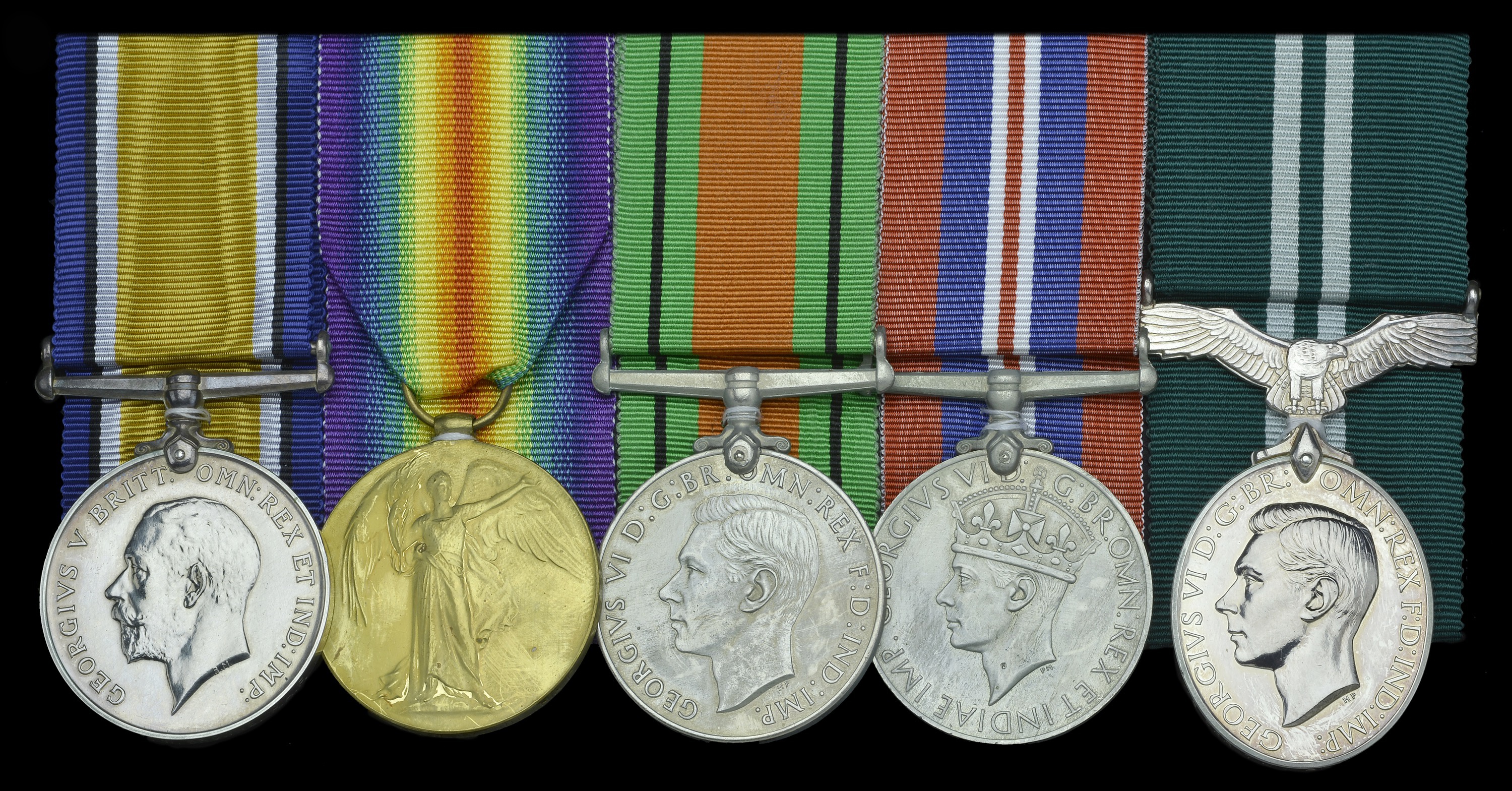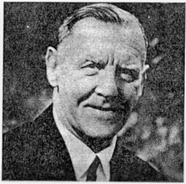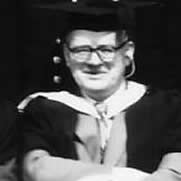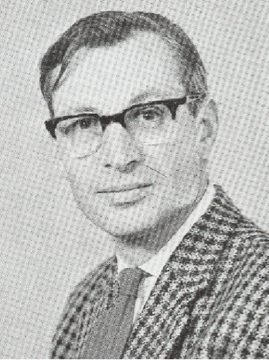| 7. |
1 Feb
1935 - 31 Aug 1939 |
Thomas Ethelred Wilby BROWNE MA MSc. (Spitfire, Tom, TEWB) Wing Commander (N), RAF
MA BSc (Oxon), MSc (Wales), ARIC (Hertford College, Oxford)
Actually started on staff in Sep 1934, presumeably to inderstudy Mr Marchant.
Joined from Oakham School where he had been 6th Form Physics Master
Educated at University Colleg, Bangor and Hertford College, Oxford.
Called "Spitfire" in the 1940s as he was ex RAF although he also spent soem time in the RN. More generally know
as "Tube" because of his initials.
Letter to The Cadet 1940.
Ditto from him in the RAF
As headmaster, he also taught
Physics. Wore a gown and mortar-board. When perplexed he had the habit
of scratching his stern and then vigorously rubbing his nose, saying
“Most extraordinary! Most extraordinary!” Liked by everybody.
He served in the Royal Air
Force Volunteer Reserve and Royal Naval Air Service and flew as a
Handley Page pilot during the Great War, narrowly averted death when he
crash landed returning from a long range bombing raid to Frankfurt, 21
August 1918. He later published his memoirs The Skyline Is A Promise,
which cover his Great War and Second War service, and chronicle his
time as Headmaster of Conway, see Bibliography
He was born at 26 York Street,
Heigham, Norwich, in October 1899 and educated at the City of
Norwich School.
After school he was commissioned as aProbationary Flight Officer, Royal
Naval Air Service, in September 1917. After an initial posting to the
Royal Naval College, Greenwich, Browne was posted to the Flying
Training School at R.N.A.S. Chingford. He flew his first solo in a
D.H.6 in February 1918, and carried out further training in 504K Avros
at Fairlop. Browne was posted to Cranwell in March 1918, and after some
preliminary training on B.E.’s he was posted to Scout Flight for
fighter training. This did not last long, as he was subsequently posted
to the Handley Page flight. After attending courses at the Bombing and Gunnery School, Eastchurch,
and on Night Flying and Navigation at Stonehenge, Browne was posted as
pilot for operational service with 16 (Naval) Squadron (Handley Pages),
Ochey, France, in June 1918. Operating as part of Trenchard’s
Independent Force in France, the Squadron was engaged on long range
bombing operations over Germany until the Armistice.
Browne describes one of these long range raids in his autobiography:
‘My observer for my
longest raid, on the railway yards at Frankfurt on August 21st, 1918,
was a young Canadian, J W Adams.... he was a good navigator and he laid
our course faultlessly on that moonlight night to take us over to the
Rhine Valley and then down the faint silver ribbon of the river winding
northwards to our target. To the jet pilot of today we would have
looked uncomfortably primitive sitting side by side in the open cockpit
hauled through the night by our two Rolls Royce engines at a mere
seventy miles per hour. But for us there was more than a tinge of pride
in taking the biggest aircraft then known carrying the heaviest load
over the longest distance into enemy territory. For the actual bombing
run Adams had to crawl through a very small opening into the front
cockpit the sides of which were barely waist high, lean over the open
bomb sight, and direct me over the target by waving his arms. There was
during all this a considerable concentration of searchlight beams, red
flashes, dull woofs, and a few unpleasantly loud cracks. At last the
run was over and I could make a steep diving sideslip to take us out of
the beams and the barrage as quickly as possible....
From our base to Frankfurt and back would be hardly an hour’s run for a
modern jet, but we had been flying for nearly six when we picked up the
light which told us we were only about fifteen miles from home.... We
were only about 500 feet above the ground when there was a hesitant
cough from the starboard engine and it died. I opened up the port
engine to full revs and began to make a turn to get over the thick
woods into the open field below, but half way through the turn that
engine too spluttered to a stop.... I decided to attempt a landing on
the near side of the wood where there was a limited stretch of flat
ground rather than try to stretch my glide and run the risk of stalling
in an attempt to reach the field on the far side. Hauling on the wheel
I tilted the eighty foot wing span into a ponderous sideslip and
touched down about a hundred yards from the trees. The most powerful
brakes could not have stopped several tons of aeroplane in that
distance. We had no brakes. I pictured the nose meeting the first large
tree trunk and driving the edges of the cockpit together like the
blades of a pair of shears with both of us being messily decapitated,
so I shouted to Adams to get down behind the bullet proof seat. He
slipped back and I followed as soon as I felt sure that we would not
get airborne again. The four big wheels hit the bank at the edge of the
wood, bounded up for their last brief take off, and plunged into the
trees. The silence after the first splintering crashes subsided seemed
almost unreal. We crept out of
our refuge and saw that the nose had thrust itself up between two large
trees with the cockpit still open and undamaged... a shout from Adams
sent me out pretty damn quick. ‘Get out, Brownie. The damn thing’s on fire.’ In seconds a great tower
of flame roared up into the sky and we had to run hard to escape the
searing heat, having stopped just long enough to collect the rear
gunner... as we persuaded him to jump clear the ammunition drums caught
the fierce heat of the fire and brilliant flashes streaked round us as
the tracer cartridges exploded.’
Despite
rumours to the contrary, his diaries and autobiograpahy make it clear
he was not the first man to land on an aircraft carrier in WWI, he
never landed on a carrier.
After the war, Browne was posted to 167 Squadron at the Long Distance
Experimental Establishment at Bircham Newton. He was placed on the
Unemployed List in February 1919, and returned to education studying at
Bangor University. In 1922 he embarked on a career as a schoolmaster,
and taught at Bourne Secondary School, Lincolnshire, Lucton School,
Herefordshire and Magdalen College School, Brackley. When the Reserve
of Air Force Officers was formed in 1923, he applied and was appointed
Pilot Officer on probation. Browne undertook a refresher course at the
De Havilland civilian flying training school at Hendon, and was
confirmed as a Pilot Officer in October 1923.
Browne returned to education once again, and read Chemistry at Oxford
from 1928. He advanced to Flight Lieutenant in July 1930, and to
Squadron Leader in November 1937. After Oxford he taught at Oakham
School, until appointed Headmaster of the Cadet School Ship H.M.S.
Conway at Rockferry in 1934. Browne re-engaged for service with the
outbreak of the Second War, and was posted as Officer Commanding Flying
at the Bombing and Gunnery School at Jurby, Isle of Man. The posting
was brief, and in November 1939, he was posted as Group Liaison
Officer, No. 25 (Armaments) Group, Flying Training Command. Subsequent
postings included to the Specialist Navigation School in May 1941 -
this being transferred from St. Athan to Canada and re-designated No.
31 Advanced Navigation School, Port Albert.
Having qualified as a Specialist Navigator, Browne was appointed staff
officer in command of Navigation, No. 1 Training Command, Toronto. The
latter appointment meaning a secondment to the Royal Canadian Air
Force, and stay of two years in Canada. Browne advanced to Wing
Commander in January 1943, and navigated his own return to the UK in a
Martin Marina Flying Boat in October of the same year. He was posted as
Chief Instructor, No. 6 Advanced Flying Unit, Staverton, in 1943
(awarded Air Efficiency Award in the same year). The following year
Browne took up his last wartime appointment, on the staff of No. 29
Group, Dumfries, before being demobilised in June 1945. His medals from
WWI and WWII are below.

Post-war Browne returned as
Headmaster of H.M.S. Conway, in which capacity he continued to be
employed until his retirement in 1964. In the latter year he oversaw
the opening of the new buildings by Prince Philip. His daily diaries
show him to have been very forward thinking and he had firm views about
how Conway training needed to be updated and to evolve. These brought
him into frequent high conflct with Captain Superintendent Hewitt who had less
progressive views on nautical training. TEWB's inability to get his ideas adopted undoubtedly contributed to Conway's eventual demise as
her training did not adapt to modern shipping company needs. When
politcal pressures threatened Conway's future the shipping companies
did not rally round her; she was not producing the sort of cadets
they neeeded so they had started training their own boys. At the very
momemt Conway most need their support they no longer relied on her as the main source of their recruits. Browne had seen the writing on the wall, the Captain Superintendent had not.
He orgainsed the Snowdon Scout
Group for may years. He was Assistant Commissioner for North Wales
Scouts Training, leader of the UK contingent to the Jamboree at Niagara
on the Lake, Canada, in 1955. He was also a Sea Scout Commissioner for
a time. In retirement he continued his association
with the Scouts being Assistant Commissioner in North Wales. In
recognition of his service with the Scouts Association he was awarded
the Silver Wolf in 1965. See http://www.scoutscymru.org.uk/sites/default/files/snowdonia_anglesey.pdf
Browne died at his home ‘Kelvin’, Old Quay Lane, Neston, Wirral, in June 1973.
| 
|



